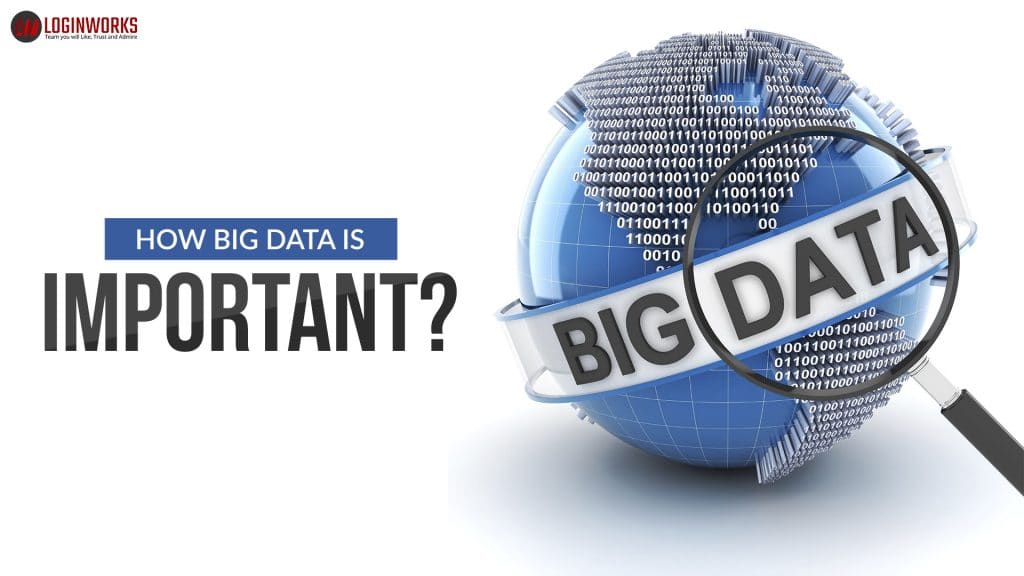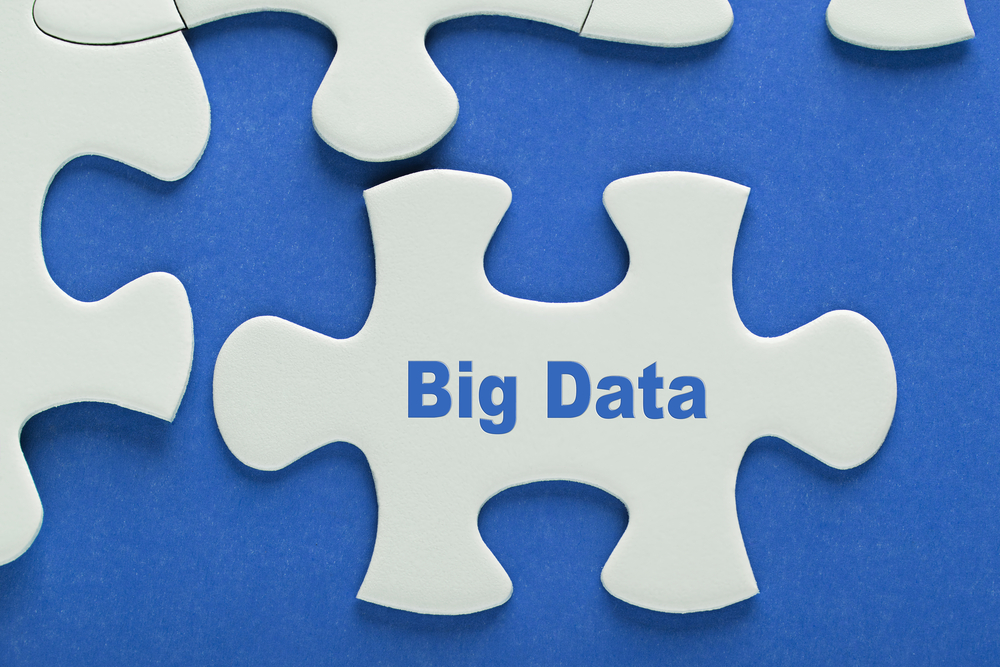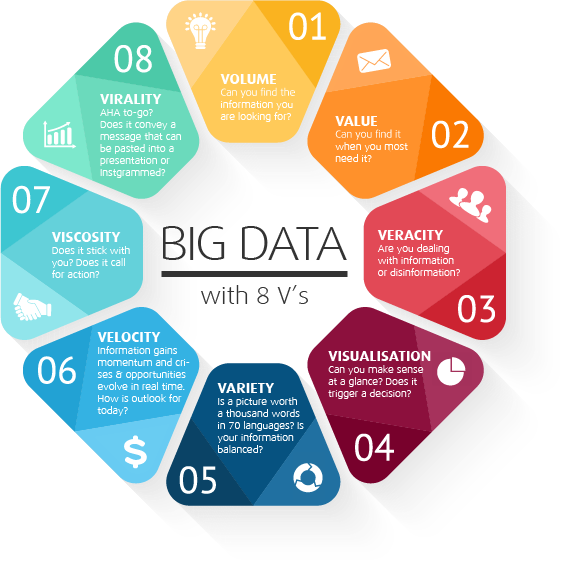Big data is a term that defines the data sets that are too large or complex. Additionally, it involves both structured and unstructured data.
This type of data is collected from a number of sources including:
- Mobile devices,
- Mobile applications,
- Emails, servers,
- Databases, and other means.
Big data, when formatted, captured, stored, manipulated, and then analyzed, can help a company to gain important and useful insight. This insight can be used to retain or get customers, increase revenues and improve operations. Or, in other words, it has the ability to mine for information and can be used in machine learning projects and other advanced analytics applications.
The scope of big data is, well, big. However, this huge amount of information can be broken down for experiences that prompt better choices and key business moves. After all, big data is also known to be the collection of a huge set of data which are able to process using traditional computing techniques. The testing of theses from a collected huge set of data involves different tools, different techniques, and different frameworks to process.
In this article, I will be guiding you through the usage and importance of Big Data.
Jump to Section
What Are 8 Vs of Big Data?
Volume
The measure of information matters. With huge information, you’ll need to process high volumes of low-thickness, unstructured information. This can be information of obscure esteem. Like for example, Twitter information channels, click-streams on a site page or a portable application, or sensor-empowered gear. For reference, this may be many terabytes of information. For other people, it might be several petabytes.
Velocity
Velocity is the quick rate at which information is gathered and (maybe) followed upon. Usually, the most noteworthy speed of information streams straightforwardly into memory as opposed to being composed to plate. Some web-empowered savvy items work continuously or close to constantly and will require ongoing assessment and activity.
Variety:
Variety refers to the numerous kinds of information that are accessible. Customary information types were organized and fit perfectly in a social database. With the ascent of huge information, information comes in new unstructured information types. Unstructured and semi-structured information types, for example, content, sound, and video need extra pre-processing to infer importance and help metadata.
Viscosity
Viscosity alludes to the latency while exploring through an information gathering. This is true because of the assortment of information sources, the speed of information streams, and the multifaceted nature of the required handling.
Value
Value refers to the esteem that could be separated from specific information and how Big Data systems could expand this esteem.
Virality
Virality measures the speed at which information can spread through a system.
Visualization
Visualization is a general term that portrays any push to enable individuals to comprehend the importance of information by putting it in a visual setting. Examples, patterns, and relationships that may go undetected in content-based information can be uncovered and perceived less demanding with information perception programming.
What Is the History of Big Data?
In spite of the fact that the idea of huge information itself is generally new, the inceptions of vast informational indexes return to the 1960s and ’70s when the universe of information was simply beginning with the primary server farms and the improvement of the social database.
Around 2005, individuals started to acknowledge exactly how much information clients produced through Facebook, YouTube, and other online administrations. Hadoop (an open-source system made particularly to store and investigate huge informational indexes) was created that equivalent year. NoSQL additionally started to pick up ubiquity amid this time.
The advancement of open-source systems like Hadoop (and all the more as of late, Spark) was fundamental for the development of enormous information. This is so because they make huge information less demanding to work with and less expensive to store. In the years from that point forward, the volume of enormous information has soared. Clients are as yet producing immense measures of information—yet it’s not simply people who are doing it.
With the coming of the Internet of Things (IoT), more questions and gadgets are associated with the web, gathering information on client utilization examples, and item execution. The development of machine learning has delivered still more information.
While huge information has made significant progress, its helpfulness is just barely starting. Distributed computing has extended huge information conceivable outcomes significantly further. The cloud offers genuinely versatile adaptability, where designers can basically turn up impromptu bunches to test a subset of information.
Why Is Big Data Important?
The significance of enormous information does not spin around how much information an organization has yet how an organization uses the gathered information. Each organization utilizes information in its own particular manner. The more effectively an organization utilizes its information, the more potential it needs to develop. The organization can take information from any source and break down it to discover answers which will empower:
Saving in Cost
A few instruments of Big Data like Hadoop and Cloud-Based Analytics can convey cost focal points to business when a lot of information is to be put away and these apparatuses additionally help in distinguishing more proficient methods for working together.
Reduction in Time
The fast of apparatuses like Hadoop and in-memory examination can without much of a stretch recognize new wellsprings of information which helps organizations investigating information instantly and settle on snappy choices dependent on the learning.
Comprehend the economic situations
By dissecting huge information you can show signs of improvement in comprehension of current economic situations. For instance, by dissecting clients’ acquiring practices, an organization can discover the items that are sold the most and deliver items as indicated by this pattern. By this, it can advance beyond its rivals.
New Product Development
By knowing the patterns of client needs and fulfillment thorough investigation you can make items as per the needs of clients.
What Makes Big Data Different?
A couple of years back, we would use frameworks to separate, change and load information (ETL) into monster information stockrooms that had business knowledge arrangements worked over them for revealing. Intermittently, every one of the frameworks would reinforce and consolidate the information into a database where reports could be run and everybody could get knowledge into what was happening.
The issue was that the database innovation just couldn’t deal with various, ceaseless floods of information. It couldn’t deal with the volume of information. It couldn’t adjust the approaching information continuously. Also, detailing apparatuses were deficient with regards to that couldn’t deal with anything besides a social inquiry toward the back. Enormous Data arrangements offer cloud facilitating, exceptionally ordered and enhanced information structures, programmed documented and extraction abilities, and detailing interfaces have been intended to give more exact investigations that empower organizations to settle on better choices.
Better business choices imply that organizations can diminish the danger of their choices, and settle on better choices that lessen expenses and increment promoting and deals adequacy.
Benefits: Big Data
- As per the analysis, about 60% of every workday, learning laborers spend endeavoring to discover and oversee information.
- Half of the senior officials report that getting to the correct information is troublesome.
- Information is at present kept in storehouses inside the association. Advertising information, for instance, may be found in web investigation, portable examination, social investigation, CRM, A/B Testing devices, email showcasing frameworks, and then some… each with the spotlight on its storehouse.
- 29% of organizations measure the money-related expense of poor information quality. Things as straightforward as checking various frameworks for client contact data updates can spare a great many dollars.
- 43% of organizations have been disappointing with their apparatuses’ capacity to sift through unimportant information. Something as basic as separating clients from your web examination can give a huge amount of knowledge into your procurement endeavors.
- The normal information security break costs $214 per client. The protected foundations have work by enormous information facilitating and innovation accomplices can spare the normal organization 1.6% of yearly incomes.
- 80% of associations battle with various variants of reality relying upon the wellspring of their information. By consolidating numerous, confirmed sources, more organizations can create profoundly precise insight sources.
- Outdated or awful information results in 46% of organizations settling on awful choices that can cost billions.
Testing Strategy: Big Data
Testing Big Data application is increasingly a check of its information handling instead of testing the individual highlights of the product item. With regards to Big information testing, execution and user testing are the keys.
In Big Data testing, QA engineers confirm the fruitful preparing of terabytes of information utilizing ware bunch and other steady parts. It requests an abnormal state of testing aptitudes as the preparation is quick. Preparing might be of three sorts:
- Batch
- Real-Time
- Interactive
Alongside this, information quality is likewise an essential factor in huge information testing. Prior to testing the application, it is important to check the nature of information and ought to be considered as a piece of database testing. It includes checking different attributes like congruity, precision, duplication, consistency, legitimacy, information culmination, and so on.
Conclusion
The utilization of Big Data is getting nowadays by the organizations to outflank their companions. In many ventures, existing contenders and new contestants alike will utilize the procedures coming about because of the examined information to contend, enhance and catch esteem.
Huge Data encourages the associations to make new development openings and totally new classes of organizations that can consolidate and break down industry information. These organizations have sufficient data about the items and administrations, purchasers and providers, shopper inclinations that can be caught and broke down.
It additionally comprehends and streamlines business forms. Retailers can undoubtedly improve their stock dependent on prescient models produced from web-based life information, web look patterns, and climate estimates.
With this, we come to an end of this tutorial on “How Big Data is important ?”. I hope this will help you to improve your knowledge to work on Big Data.
However, suggestions or queries are always welcome, so, do write in the comment section.
Thank You for Learning!!!
- What Products Should You Sell on Amazon? - November 18, 2020
- 10 Reasons Why You Should Start Selling on Amazon - October 22, 2020
- Comparative Study of Top 6 Web Scraping Tools - September 3, 2020




